Mastering Your Atlassian Cloud Migration: Key Strategies and Insights
At the beginning of this month, Automation Consultants (AC) were honoured to host our biggest event yet, ‘Your Journey to the Atlassian Cloud’ alongside our sponsors Atlassian and AppFox. While we would have loved to see you all in person, we were delighted that so many of you joined us virtually for the event.
The afternoon was filled with plenty of thought-provoking sessions, discussions and insights, as industry experts joined us from across the globe to share their experiences with the Atlassian Cloud. From hearing AC’s very own tips about Cloud Migration, to the Atlassian Keynote delivered by Tolga Özgentürk, through to our interactive panel, the event had it all!
The event kicked off in the traditional way with a warm welcome from our Director Francis Miers, as he introduced the main theme of the event ‘the migration to the cloud, and how to make the most of that more powerful platform once there.’ He gave us a sneak peek into the many insightful sessions in store for us throughout the event, and thanked our wonderful sponsors Atlassian and AppFox.
Atlassian Cloud Migration: Strategy Not Tragedy
Our first talk of the day was given by AC’s very own Head of Operations, Emma Thomas, in her talk about how to plan your migration strategy to ensure that you have the best possible journey to the Atlassian Cloud. Throughout the presentation Emma discussed the key things to consider when planning your Cloud migration strategy and highlighted some of the key pitfalls that you might want to avoid.
She outlined that when defining your migration strategy and method, you might want to ‘assess the existing landscape of Atlassian applications and determine if there is anything that needs to be done prior to migrating.’ You might need to consider if your Atlassian applications are stable and performant, if you need to upgrade your instance to a later version that is compatible with a migration to the Cloud, and you may need to understand how your applications are currently configured. Emma also outlined that you may need to consider reducing the number of migrations required, aim to minimise the amount of data that is migrated and be sure to perform data clean up and configuration optimisation activities as part of the migration.
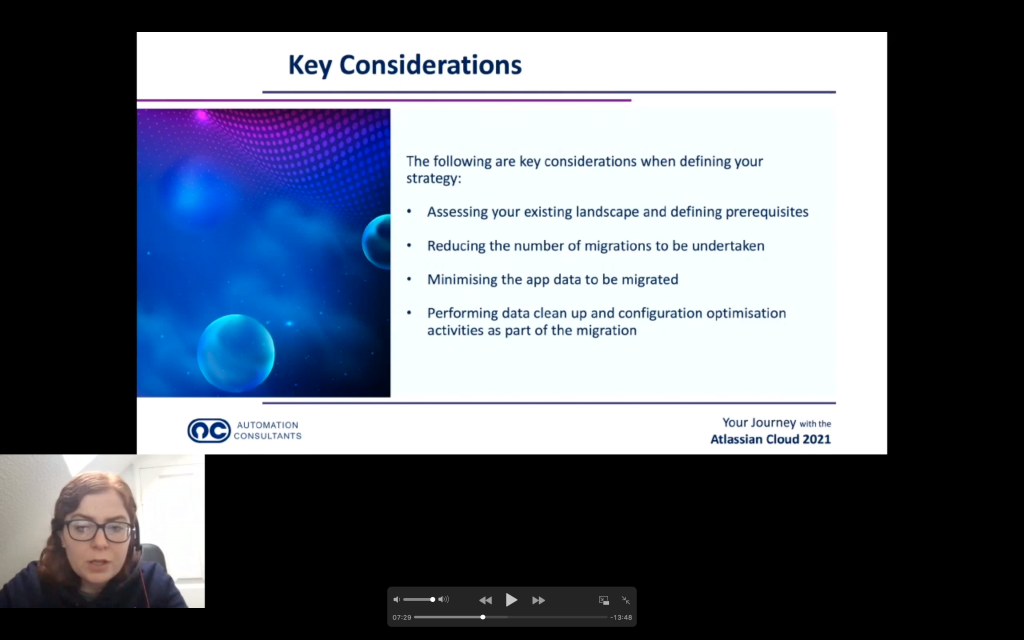
Keep these considerations in mind when planning your migration and you should be on for a winner!
During her talk, Emma shared with us some valuable insights into AC’s recommended approach for your migration strategy. In case you didn’t catch it, here are the highlights:
- Perform a trail migration
- Accept compromise when necessary
- Regularly engage with customers, keep them updated throughout the process and involve them in user acceptance testing.
- Use major change as an opportunity for optimisations, performance and standardisation.
- Utilise a phased approach.
At AC we really specialise in Cloud migration strategy and we’re more than happy to discuss your migration strategy with you! Continue the conversation with Emma and our migration team with a free 30-minute consultation session.
From Cloud to Server to Cloud and sort of back to Server: A tale of just in time migrations to meet requirements
Next up on our Main Stage we heard from Bruce Kozuma, Senior Group Product Manager at Ginkgo Bioworks. In his talk, Bruce discussed the complicated journey that Ginkgo Bioworks has had with Jira and Confluence. He outlined the company’s multiple migrations, from Cloud to Server to Cloud and sort of back to Server and addressed why these multiple movements were necessary to meet their requirements.
During his talk, Bruce gave an overview of his Atlassian Journey and outlined the company’s Atlassian portfolio. He discussed that back in 2020, when Ginkgo Bioworks only had one instance in the Atlassian Cloud, they made the decision to Migrate to Confluence Server and Jira Software Server to enable scale. However, towards the end of the year, and in light of the pandemic, Ginkgo Bioworks migrated back to the Cloud as this could now scale. Bruce went on to discuss that in 2021, Ginkgo Bioworks signed a contract with Concentric which required all their data to be HIPPA compliant, and thus requiring a migration from Cloud back to server to meet this specific requirement. What a Journey!
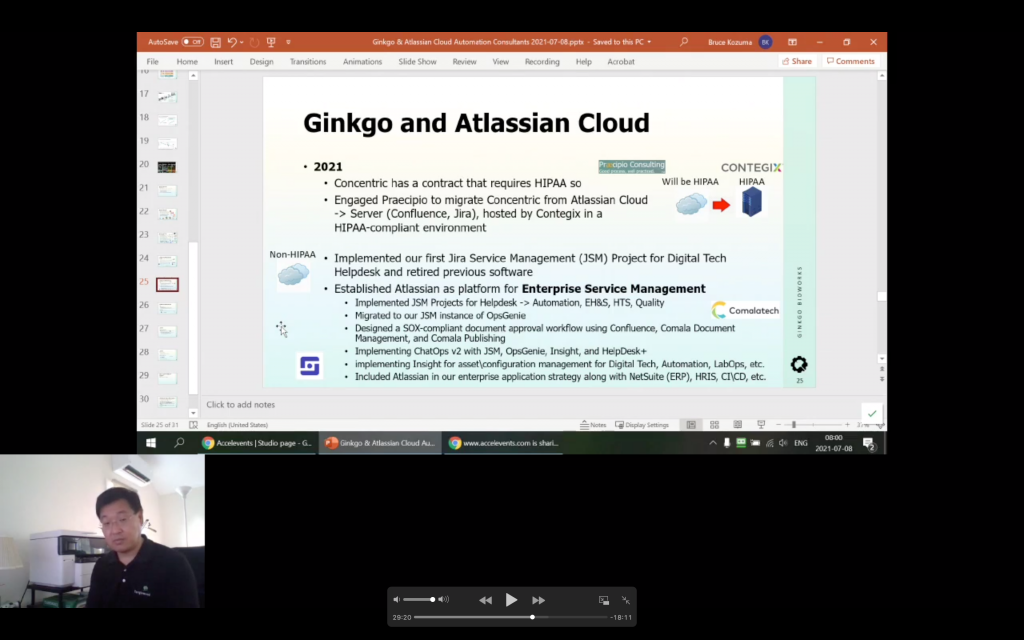
Bruce walked through lessons learnt from his multiple experiences of migration between Server and the Cloud, including:
- Learn from experience
- Focus on your core competency
- Use a partner when migrating to the Cloud.
- Take on frequent feedback.
The talk concluded with Bruce outlining Ginkgo Bioworks’ plans for the future, their ambitions for more digital infrastructure and their hope for more partnerships.
Are you burdened with Traceability Matrices?
How digital health, banking, and automotive teams can ace their traceability needs on the Atlassian Cloud.
If the opening sessions weren’t already enough, up next we had Rina Nir, CEO of RadBee, in her fantastic presentation where she shared her expert tips on creating custom traceability matrices and release documents in the Atlassian Cloud. If you’re in the digital health, automotive, environmental sciences, or banking sector, you’ll already know how critical it is to efficiently manage traceability in the Atlassian Cloud.
While many people are already using Jira and Confluence to manage traceability matrices, Rina’s live interactive poll showed us that many people still use other platforms to manage their traceability and have not yet migrated over to managing this on the Atlassian Cloud.
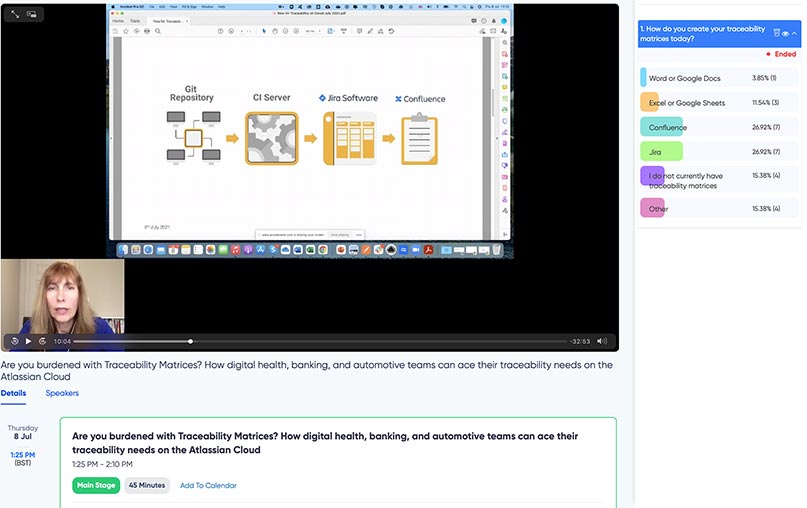
Throughout her session, Rina discussed how you can be using Jira and Confluence to manage your traceability, how to understand if traceability in Jira fits your business needs, and outlined what can be achieved by utilising Jira’s traceability features. We gained valuable insights into how to automate Quality Assurance and how to remain compliant. Rina covered the whole journey, right from the basics to the precise tooling that may be required for traceability matrices.
Not only that, but we also even got to see a live demo… and it didn’t disappoint.
If you wanted to know more about how to achieve traceability in Jira, here are some apps that you might want to consider:
- Speedy PDF Sing-Offs (by RadBee)
- Xray Test Management for Jira
- Structure – Project Management at Scale
- Risk Register
- ScriptRunner for Jira
And we didn’t forget about Confluence… For release documents in Confluence, here are some apps that you should check out:
Business Teams and the Atlassian Cloud
Following on, we had AC’s very own Christina Deligiorgi discussing why business teams are adopting Jira Cloud to enhance their collaboration. She outlined the many benefits of using Jira Cloud, such as Cross-team transparency, increased efficiency of business processes and enhanced productivity across the team.
Christina went on to highlight some fantastic insights into Atlassian’s new cloud product, Jira Work Management which is designed with Businesses in mind and aims to provide teams such as Marketing, HR, Finance and Sales with a purpose-built product. She shared with us the benefits of Jira Work Management, such as increased transparency between technical and non-technical teams as well as instance-time-to-value from the product.
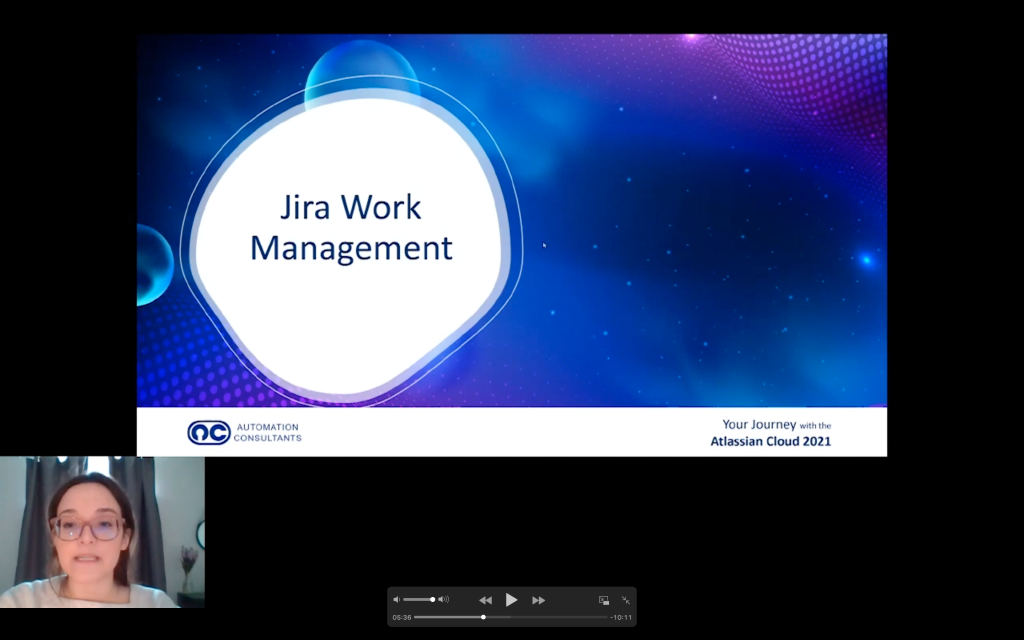
If that wasn’t already enough, Jira Work Management also comes with a range of new features:
- List View
- Calendar View
- Form Builder
- Timeline View
- Board Review.
Christina brought her session to a close with an amazing live demo of Jira Work Management… we were hooked! If you’re not already using Jira Work Management as part of your business, then this is definitely worth checking out.
ITSM in the Cloud
We’ve got even more in store for you! Up next we had Kathi Paquet, Senior IT Consultant at Centric Consulting, in her talk discussing IT Asset & Service Management in the Cloud. As many of you may already know, transitioning to a new IT Asset and Service Management system can be challenging and it is often difficult to find the right balance between a traditional help desk and ways to communicate with agile teams throughout the organisation.
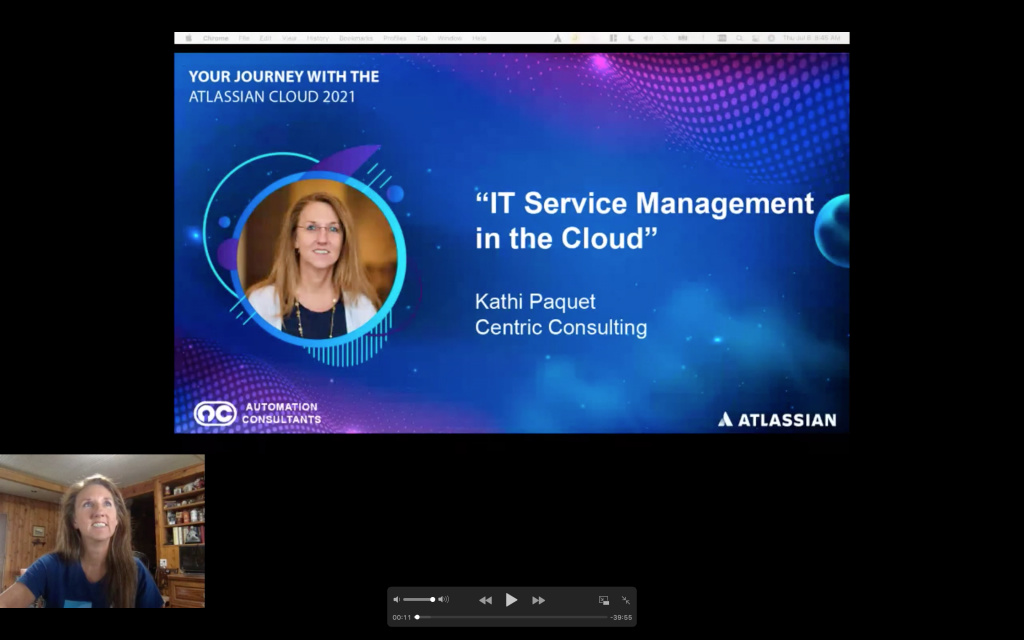
Throughout her talk, Kathi discussed a case study of deploying Jira Service Management. The organisations decision to move to Jira Service Management, presented an opportunity for Centric Consulting to evaluate the current processes of the organisation’s asset and service management team, design a user friendly interface, implement ITIL best practices, and integrate with Jira Software.
As well as this, Kathi outlined the key steps that you might want to include in your implementation strategy and outlined Centric Consulting’s agile approach.
In case you missed it… Here was the recommended agile approach to configure Jira Service Management:
1: Partnering approach
- Steering Committee
- Outline of activities
- Define deliverables and actions
2: Look at assessments and recommendations
- Review Current Support Process
- Identify Gaps
- Recommendations
- Build out action items
- Change Request Journey Mapping
3: JSM configurations
- Request Type Configurations
- Define customers, users, and project roles
- Agent Workspaces and Queues
- SLA’s
- Automation
- Jira Software Project integrations
4: Customer portal
- Define types of requests
- Message Configuration
- Specific groups or organisation
- Permissions
5: Knowledge base
- Setup a Knowledge- base for self-service
- Guidelines for creating spaces
- Create Templates for How To & Knowledgebase Articles
6: Training
- Communication Strategy
- User Acceptance Testing.
- Agent User Manual
- Agent and support training
- Customer training
- Administration Training
The Atlassian Keynote
Next up we had the highly anticipated Atlassian Keynote speaker and Enterprise Account Director, Tolga Özgentürk, on the benefits of the Atlassian Cloud. Tolga kept us on the edge of our seats as he shared some key statistic with us.
Did you know that it is predicted that 80% of Enterprise workloads will shift to the Cloud by 2025? What’s more is that 90% of new customers now start directly in the Cloud!
As Tolga went on to discuss, the Cloud provides many benefits to teams and admins, which are built around ‘three main pillars, extensibility, productivity, and data and insights.’ Admins may see many benefits from using the Atlassian Cloud as they can now access all their data from the same place, will see increased Governance and Controls, can operate on a larger global scale, and will enjoy increased reliability and performance, as well as security and compliance.
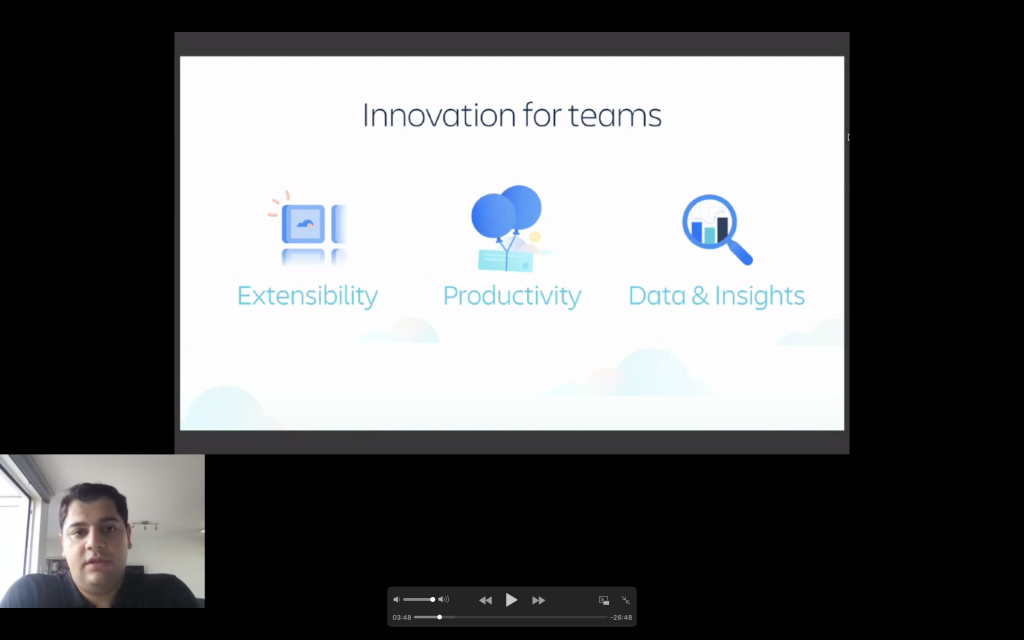
As Tolga commented, many of the apps that on-prem users will be familiar with are continuing onto the Cloud platforms, with most of the ‘app place vendors adapting their solutions to our Cloud products… making it easier for you to migrate your apps’
Tolga also shared with us Atlassian’s fantastic new update, Atlassian Forge. This app allows you to build your ‘custom apps in the Cloud, run them, post them and secure them on top of your core solutions.’ What more could you need!
Hungry to know more?
Now for our final session..
The Interactive Cloud Panel with Industry Leaders
During this long-awaited session, we had industry leaders from around the globe join us for this year’s interactive panel, where they provided first-hand solutions and answers to your crucial questions about the Atlassian Cloud. The live session was hosted by AC’s Director Francis Miers, as he was joined by Andy Farmer from Tasktop, Andrea Moscatelli from Convex Insurance, Stu Johnstone from Unai and Hermance N’Dounga from from Atlassian. These four industry professionals work in the Atlassian sphere and provided insightful and relevant expertise throughout the session.
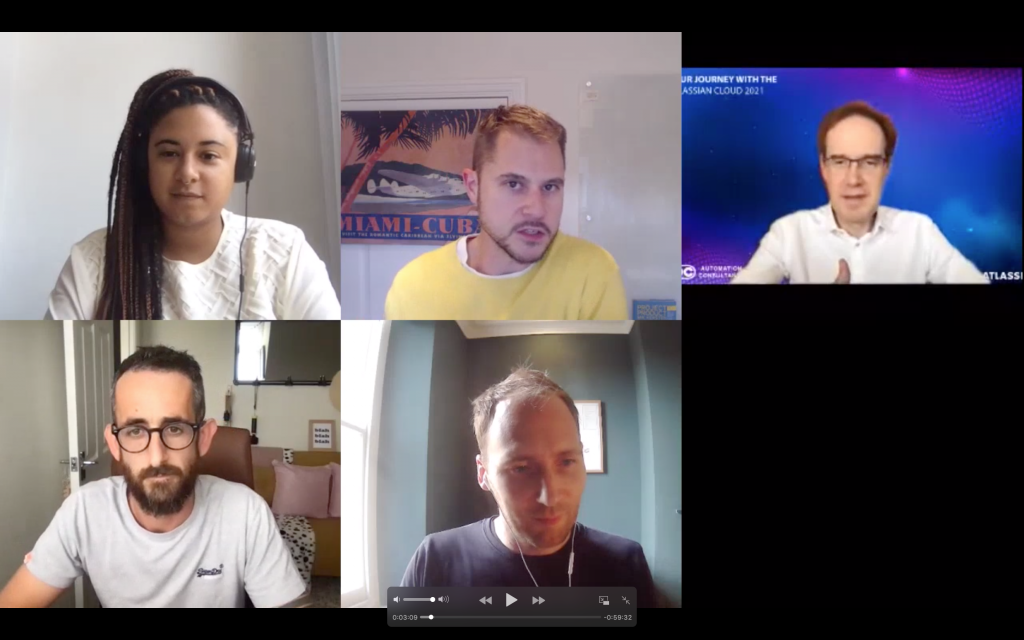
The interactive panel kicked off with Francis’ first question, ‘If your organisation is still using on-premise Atlassian products, what is the top objection to moving to the Atlassian Cloud?’
While Andrea is a true Cloud native, and began his journey in the Atlassian Cloud, our other panellists suggested that security and loss of control can often play a factor in this, as well as customers with certain compliances with HIPPA being unable to move to the cloud. The interactive poll from our audience showed that many of the audience members believe that server deployment is often the cheaper option.
Our question round continued with, ‘what are the main challenges for migrating your systems to the cloud?’
The panellists suggested that some of the challenges can be the migration of different apps onto the cloud as these can sometimes be a challenge to migrate and it can often be a manual time-consuming process. Moreover, they suggested that migration is often a complex project which requires a lot of planning and in the initial stages it can often feel like a huge task to embark on. There can also be a range of challenges when certain teams wish to move onto the Cloud, and other teams in the same organisation are reluctant – as many of you may already know, moving to the Cloud is a big cultural change.
Next up, Francis asked our panellists, ‘in your experience do Atlassian applications perform better in the cloud or on premise?’
Many of our panellists suggested that there are a range of factors which can impact the performance of both cloud and on-premise setups. Tasktop’s Andy Farmer suggested that when using Jira Cloud, Atlassian will often pick up any performance issues and address them right away. However, with on-prem, there can sometimes be a concern any performance issues have the potential to impact Jira instances and may not be picked up as quickly as in the Cloud. During the discussion, Unai’s Stu Johnstone commented that he has never had any issues with performance on either platform, and has been using the Cloud exclusively for the last 4/5 years!
The session was filled with a range of fantastic questions, and insightful answers. Each panellist offered a unique viewpoint and this really made for an engaging discussion. In case you missed the whole panel, here’s a few teaser questions covered by Francis and our Cloud experts:
- ‘How will the IT departments of the. Future compare with the conventional on-premise IT departments’?
- ‘How will the adoption of Atlassian Cloud products lead to more or less integration of Atlassian systems with systems belonging to third parties like customers and suppliers’
- ‘In your experience, what are the main differences for users of the Atlassian Cloud.’
If you want to hear more from our wonderful panellists, then head over to our on-demand session to watch the full discussion.
And before we wrap it up… We had our virtual shindig! What a way to round off a wonderful day. Thank you to all those who joined us in the cloud lounge for our virtual networking session, it was great to kick back, relax and chat with some familiar faces.
That’s not all from us, head over to our Breakout Session blog to join the rest of the fun!
From everyone at AC we’d like to give a big thank you to everybody who spoke on our Main Stage. We had so many wonderful speakers and we really couldn’t have done the event without you all! We hope that we get to see you all face-to-face for our next shindig very soon – fingers crossed!
Did you manage to catch all the sessions? Or fancy giving some of them a re-watch?